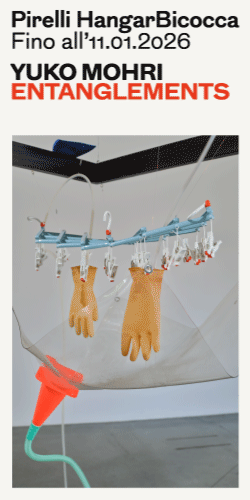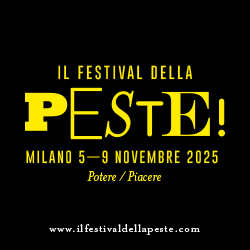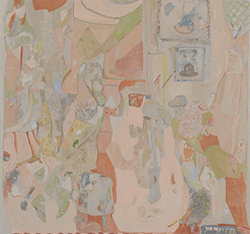[nemus_slider id=”58715″]
The Workbench è un’associazione di promozione sociale non a scopo di lucro, il cui spazio è stato ricavato dal recupero di un vecchio laboratorio orafo nel quale sono rimasti alcuni arredi. In particolare vi sono due file di banchi da lavoro (dai quali è tratto il nome dello spazio), il pavimento unico nel suo genere che serviva a trattenere l’eventuale uscita di pagliuzze d’oro all’esterno del laboratorio, e un imponente macchinario in metallo che accoglie i visitatori all’ingresso.
Presentando progetti d’arte contemporanea, The Workbench si connota come un luogo pensato per far emergere parallelismi, somiglianze e contrasti fra l’attuale progettualità artistica e la tradizione artigianale evocata dall’ambiente.
L’idea di collegare arte contemporanea e antica tradizione dell’artigianato orafo, due mondi differenti ma complementari, si è sviluppata intorno all’idea di dar vita a mostre “ibride”, dove l’arte contemporanea entra in sinergia con l’artigianato di alto livello. The Workbench, il tavolo da lavoro, come suggerisce il nome stesso, diventa luogo di sperimentazione dove l’involucro non è un mero spazio ma il mezzo per la produzione artistica.
—
The Workbench is a non-profit organization dedicated to contemporary art in Milan, created from the restoration of an old goldsmith’s workshop in which some furnishing remained. There are two rows of workbenches, (which the space is named after), a unique floor that was used to prevent the specks of gold from going outside of the workshop and impressive metal machinery that welcomes visitors at the entrance. Presenting contemporary art projects, The Workbench is recognized as a space designed to throw up parallelisms, resemblances and contrasts between the current artistic creativity and the craft tradition evoked by the environment.
The idea of associating two different but complementary worlds such as contemporary art and ancient goldsmiths craft tradition, was developed around the idea of setting up “hybrid” expositions, where contemporary art is in tune with highquality craftsmanship.The Workbench, or worktable, as the name suggests, becomes a laboratory where the setting is not just an exhibition space but also represents an instrument for artistic production.

Hannah Lees — The Oldest Thing You Can Hold In Your Hand Curated by Pietro Di Lecce
24 September – 23 October
Il lavoro di Hannah Lees si avvale del ritmo delle stagioni, dei suoi cicli con partenze, conclusioni, ripetendo cosi? come e? la trasformazione infinita delle cose. Concentrandosi su questa variazione, si e? attratti dai processi naturali di decadimento e di mutazione, l’artista sperimenta in modo ontologico e con temporalita?, in modo tale da sovvertire la potenza intrinseca del tempo e poter plasmare il nostro mondo.
Il film sud coreano diretto da Kim Ki-duk “Spring, Summer, Autumn, Winter… and Spring “ esplora il decorso di un monastero buddista che galleggia su un lago in una foresta incontaminata. Dal tempio e non solo vediamo e conosciamo la vita dei suoi occupanti, un vecchio monaco e un giovane apprendista. Diviso in cinque segmenti, il film intriso di simbolismo, utilizza il paradigma delle stagioni naturali per esplorare la vita, la sua ricerca, l’evoluzione nel tempo e le sue diverse condizioni.
Nel segmento finale, un nuovo bambino e? stato lasciato al monastero per poi far iniziare la storia da capo. Quanto dura la proprieta? intrinseca della materia? Quanto l’ambiente circostante influisce sulle caratteristiche fisiche ed emotive? La circolarita? della primavera, dell’estate, dell’autunno e dell’inverno … e ancora la primavera, la sensibilita? e? connessa ad un paesaggio poetico e lento l’ attenzione ai dettagli e? simile all’approccio artistico di Lees, caratterizzato da una metodologia attenta ai ritmi naturali e trasformazioni inaspettate. Spesso l’artista ha raccolto i materiali durante le lunghe passeggiate nella sua citta? natale di Canterbury o sul Tamigi Bankside, Hannah Lees approfondisce analizzando il mutare della materia nel corso del tempo accostandolo ad altri processi simili.
Per la sua prima mostra personale di Milano: “The Oldest Thing You Can Hold In Your Hand” da The Workbench International, Lees utilizza come riferimento due delle piu? importanti opere storiche presenti nella citta? di Milano, l’artista analizza le feste, i rituali ed i temi centrali raffigurati nel Canestra di frutta (c.1599) di Caravaggio che sitrova nella Biblioteca Ambrosiana e L’Ultima Cena, il celebre capolavoro del tardo XV secolo di Leonardo Da Vinci che decora il refettorio di Santa Maria delle Grazie, ricollegando poi il cibo e la convivialita? alla funzione inquadrata come pratica generativa di cultura e trasformazione.
Prendendo come riferimento queste due opere, Lees mette in scena nella serata di apertura della mostra, un momento di incontro legato ad uno scambio di cibo. Utilizzando il banco da lavoro (che da? il nome allo spazio stesso ) per l’appunto The Workbench, Lees sperimenta con quello che lei chiama il rituale “eventi di pane e vino”.
Una tovaglia tinta con le verdure scartate trasforma il tavolo in una tavola imbandita sulla quale troviamo farro, pane di grano, vino rosso e bicchieri invitando gli spettatori a impegnarsi con questi elementi e creare un opera d’arte. Tutto cio? che e? lasciato sul tavolo diventa un aggancio- immagine legato ad un momento di scambio che caratterizzera? in modo sottile tutta la durata della mostra. Nel resto dello spazio si potra? ammirare tutta una selezione di nuove opere che fanno parte della ricerca di Lees, si cerca quindici avvicinare lo spettatore a gesti artistici che tendono a sovvertire le leggi naturali e a preservare momenti specifici.
Gli oggetti trovati dall’artista stessa sono stati poi fissati in gesso; compressi e semi-congelati attraverso il processo di fusione dell’argento. Guaine di bambu? sono state infilate su di un filo metallico ed incise grazie al supporto di panche di legno, l’artista ha poi, utilizzando la grafite, trasferito su carta di giornale i segni delle incisioni. L’artista avendo scelto materiali “vivi” e commestibili per i suoi interventi, tenta in un certo qual modo di ripristinare l’annientamento e la morte per poter comprendere la morfologia delle cose. I lavori e le azioni si ripetono nel tempo, rimonta e adattata a dei nuovi contesti, creando le frasi di un discorso che tende all’infinito.
Testo di Attilia Fattori Franchini

Hannah Lees — The Oldest Thing You Can Hold In Your Hand Curated by Pietro Di Lecce
The work of Hannah Lees takes the rhythm of seasons, cycles starting, ending and repeating as well as the infinite transformation of things. By concentrating on this transformation, and often attracted by natural processes of decay and mutation, she experiments ontologically with temporalities, to subvert and evidentiate time’s intrinsic power in shaping our world.
The 2003’s South Korean film Spring, Summer, Autumn, Winter… and Spring directed by Kim Ki-duk explores life in a Buddhist monastery that floats on a lake in a pristine forest. Throughout the film the floating temple and its surroundings are unfolding through the lives of its occupiers, an old monk and a young apprentice. Divided in five segments, the film embedded with symbolism, uses the paradigm of natural seasons to explore life, its quest and evolution through time and different conditions. In the final segment, Spring a new baby is left at the monastery to start the story over again. How much is time an intrinsic property of matter? How much the surrounding environment affects physical and emotional characteristics? The circularity of Spring, Summer, Autumn, Winter… and Spring, the sensibility it embraces through the poetic scenery and slow attention to details resembles Lees’ approach to art making characterised by a methodology attentive to natural rhythms and unexpected transformations. Often generated through personal dérive that lead her to gathering materials on long walks in her hometown Canterbury or on the Thames bankside, Lees applies repetition to deepen her analysis of evolution, in this case of matter mutating over similar formats and processes.
For her first Milan show, The Oldest Thing You Can Hold In Your Hand, Lees uses two of the city most important historical artworks as a starting point to explore ideas around display, feasting, ritual and participation, core topics in her practice. The works, Basket of Fruit (c.1599) by Caravaggio at Biblioteca Ambrosiana and The Last Supper, the famous late 15th-century masterpiece by Leonardo Da Vinci decorating the refectory of Santa Maria delle Grazie, feature food and conviviality framed as generative practice of culture and transformation. Keeping these two works in mind, Lees stages on the opening night a moment of encounter around food exchange. By using the characteristic workbench, which also gives name to the space, Lees experiments forward with what she calls Bread and Wine events. A tablecloth dyed with discarded vegetables transforms the bench into a table dressed with Einkorn wild wheat bread, red wine and glasses inviting the viewers to engage with these elements and create a participatory artwork. Whatever is left on the table becomes a snare-picture of a moment of exchange, fixed but subtly morphing for the duration of the show.
The rest of the space is filled with a selection of new and on-going works that form part of Lees’ research and interest, introducing the viewer to artistic gestures that tend at subverting natural laws as well as preserving specific moments. Found objects are fixed in plaster; Tablets (on-going) and seeds are frozen through the process of silver casting. Bamboo sheathes are strung on metal wire and carved graffiti on wooden benches is transferred to newsprint paper with graphite. By choosing live and edible materials for her interventions Lees attempts to revert annihilation, death and variation also embracing this limitations as tools to understand the morphology of things.Works and actions are repeated over time, restaged and adapted to new contexts creating the sentences of a discourse that tends to infinity.
Text by Attilia Fattori Franchini

Piotr Skiba — Never is a very long time
02.07.2016 15.08.2016
The exhibition curated by Wschód / www.galeriawschod.com
Anger occurs only on good days. The truth is that there isn’t much of it left. The truth is that the forms I see are slowly turning into empty shells. They keep no content. They’re but shapes. A train, a wall, a world. Or a human being. Something is hanging in pointless dismemberment in howling hollow. The existence of that something can’t be described in terms of senses. Its meaning. How should I seek connection with this thing?
Cormac McCarthy
Ero solo mentre correvo lungo il bordo del fiume, un’ora dopo una tempesta ruppe dei grandi alberi dai quali fuoriuscì una luce gialla, splendente. Nel parco due donne stavano esaminando i danni causati dal vento e dissero qualcosa. E ‘ stato un commento o, meglio, una metafora. Una selezione interessante e semplice di alcune parole che contenevano tale evento nella sua interezza. Più tardi stavo cercando di ricordare quella frase, ma invano. Nel profondo ho cercato di scavare nella mia memoria, tanto più scavavo tanto più il ricordo di quelle ore dopo la tempesta diventava incompleto. Infine, ha perso il suo nucleo di luce. Invece ho sentito un senso di frammentarietà straziante. Ho cercato più volte di consolarmi pensando che in realtà l’incompletezza è una trappola; non c’è niente di peggio di cercare una “compulsiva” omogeneità. La promessa senza forma, in lontananza, è una bugia. Lo vuoi, ma si sa fin dall’inizio che il percorso non porta da nessuna parte. Quindi sarebbe molto meglio se questa parola non sia mai esistita. Gli alberi caduti erano bellissimi. corro ogni giorno da quelle parti. Li ho visti in pieno giorno all’una del pomeriggio, incorporati in un alone blu di un’alba. Anche dopo il crepuscolo, illuminati dal cielo arancione, gli alberi non sembravano così pieni di vita come nel giorno della tempesta che li ha fatti cadere come se fossero stati malati o costituiti da un materiale fragile. Fra le rotture si potevano vedere forme espressive: taglienti, brillanti baionette che puntano in tutte le direzioni, picchi bagnati con succhi di frutta, improvvisamente esposti alla luce del giorno. Alcune sezioni del tronco piegato dal peso dell’albero che cade creando morbidi semi archi, qualcosa di simile a bande lucidate. Non ho potuto resistere ho pensato che questi alberi, distrutti erano destinati ad essere abbattuti da qualcuno con una motosega. C’erano dei rami sparsi tutti intorno: il colpo contro il terreno deve essere stato violento; ci deve essere stato un forte suono. E le foglie: bagnate, senza vita, come se si stessero già essiccando. Io correvo aprivo la strada tra gli alberi con la mano fino a quando non ho più potuto correre: ero troppo debole per spianare la mia strada quindi ci rinunciai. L’odore di ozono, inalato, tipico di una violenta tempesta, io non sapevo ancora se mai sarei stato in grado di ricordare le parole che avevo sentito poco fa; parole che contenevano esattamente quello che era successo. Quindi, solo frammenti rimarranno con me. Probabilmente per lungo tempo; se non per sempre.
Testo di Mateusz Marczewski

Piotr Skiba — Never is a very long time
02.07.2016 15.08.2016
The exhibition curated by Wschód / www.galeriawschod.com
Anger occurs only on good days. The truth is that there isn’t much of it left. The truth is that the forms I see are slowly turning into empty shells. They keep no content. They’re but shapes. A train, a wall, a world. Or a human being. Something is hanging in pointless dismemberment in howling hollow. The existence of that something can’t be described in terms of senses. Its meaning. How should I seek connection with this thing?
Cormac McCarthy
I was just running along the river’s edge, an hour after a storm that had broken down rather large trees exposing light yellow, almost shining structure of the trunks. In the park two women looking at the damages caused by the wind said something. It was a comment or, better, a metaphor. An intriguing and simple selection of a few words that contained that event in its entirety. Later I was trying to recall that sentence, to recreate it, but in vain. The deeper I dug in my memory, the more the recollection of those hours after the storm became incomplete. Finally, it lost its light core, an almost shining one. Instead I felt a harrowing sense of fragmentariness. I repeat to console myself that the incompleteness is a trap; there’s nothing worse than a compulsive seeking of completeness. The formless promise in the distance is a lie. You want it but you know from the start that the path leads nowhere. So it would be much better if that word never existed; if “completeness” were crossed off and some other word put in its place, one that would accept dismemberment and incompleteness. The fallen trees were beautiful. I run there every day. I saw them in broad daylight at 1 pm, embedded in blue halo of a dawn. Even after dusk, lit by orange sky, the trees never looked so full of life as on the day of the storm that made them fall as if they had been sick or made with some breakable material. In breakages you could see expressive forms: sharp, shining bayonets pointing in all directions, spikes bristling with other spikes, spikes wet with juices, suddenly exposed to daylight. Some sections of the trunk bended under the weight of the falling tree crown and made soft, gentle semi-arches, something like bands polished to a shine. I couldn’t resist the impression that these trees, destroyed and doomed to be cut down as soon enough somebody with a chainsaw is going to turn up and tidy them up, were the most beautiful. Branches were strewn all around: the hit against the ground must have been hard; the ground must have made a rumbling sound. And leaves: wet, lifeless, as if already drying. I was running and clearing the way in the trees with my hand until I couldn’t run anymore: I was too weak to squeeze my way through the holes in the tree crown and gave up. Inhaling the smell of ozone, typical for a violent storm, I didn’t yet know that I would never be able to remember the words I had heard a moment ago; words that contained exactly what had happened. So only fragments will stay with me. Probably for a long time; if not for ever.
Text by Mateusz Marczewski








